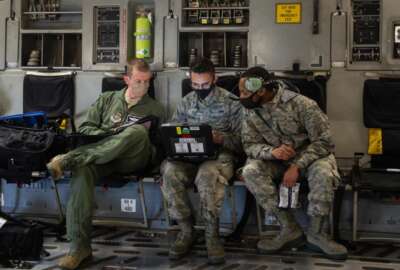
Hubbard Radio Washington DC, LLC. All rights reserved. This website is not intended for users located within the European Economic Area.
Hubbard Radio Washington DC, LLC. All rights reserved. This website is not intended for users located within the European Economic Area.
The pandemic has damaged the economy. No question about it. But it's also stimulated record levels of federal contract spending.
Best listening experience is on Chrome, Firefox or Safari. Subscribe to Federal Drive’s daily audio interviews on Apple Podcasts or PodcastOne.
The pandemic has damaged the economy. No question about it. But it’s also stimulated record levels of federal contract spending. For just how high and where the money has gone, Federal Drive with Tom Temin turned to Bloomberg Government senior defense analyst Rob Levinson.
Interview transcript:
Tom Temin: Rob, good to have you back.
Rob Levinson: Great to be here Tom.
Tom Temin: So tell us first of all the top line how much has spending increased because of the pandemic?
Rob Levinson: Well, the top line Tom is $228 billion as of the end of the fiscal 2020, which ended on September 30. Now, again, that is only for civilian agencies, we don’t have the DoD data, because it’s delayed three months. So we won’t know that until January. But this $228 billion does appear to be a record as far back as we can tell. And it boosted about 17% from the previous year, fiscal 2019, which is also it seems to be a record jump. Usually we get like single digit percent increases every year. So this was two or three times what we’ve seen in recent years.
Tom Temin: And was most of it Health and Human Services?
Rob Levinson: A good bit of it was in fact in HHS, about 44% of the total increase. So the increase over 2019 to 2020 fiscal years was $33.5 billion in total. And HHS represented about 44% of that figure. And of course, as you might expect, that was driven a lot by spending on COVID related stuff, vaccines, as well as ventilators, other biomedical research, PPE, all that kind of stuff. And then a big chunk of it also was at the VA, VA was another 13% of the total increase. And that again, we think it’s a little harder to tell with the VA, but the patient centered community contract, which pays for veterans to go outside the VA system, there was a big jump in spending on that contract, probably accounted for by COVID as well. So yeah, a lot of it was probably due to HHS and COVID. But there was some big spending increase it Department of Energy, which didn’t appear to have a lot to do with COVID, probably more with the refurbishment of the nuclear arsenal.
Tom Temin: Yes. And also some supercomputing investments. Although it’s fair to say that it may not be reflected in contract spending, they did have a big job in the COVID, because they have been loaning their supercomputers to some of the research efforts, both in the private and federal sectors.
Rob Levinson: Right. Nobody has supercomputers like the Department of Energy. And so yeah, they’ve been using it for biomedical data trying to help fight the COVID pandemic.
Tom Temin: And then SBA is also mentioned in your report.
Rob Levinson: Right, SBA, again, not a huge agency, but in terms of percentage, the jump was incredible. It went from $177 million in contracts spending in fiscal 2019 to more than $1.5 billion in 2020. So that’s a huge multiple hundreds of percentages of increase. And the driver there was of course the COVID assistance programs, the economic injury disaster loan program. Basically, the SBA had to contract with the company to sort of help it process these loans, qualified people and do all of that. And there was one big contract, the company called RER Solutions, it was originally about $330 million, and then they bumped it up about another 400 million with the total of $770 million in obligations to that one company doing this for SBA. And there’s been some concern about that contract. The IG and Congress has some questions about how that contract was awarded and expanded. So that’s still being investigated. There’s another assistance package probably will see more money going to the SBA.
Tom Temin: That was my next question. This increase, presuming that agencies already had their appropriations for that past year prior to the pandemic arriving, all of this extra money, this 17% increase in contracting came as a result of stimulus spending through primarily the CARES Act.
Rob Levinson: Right. I mean, the biomedical stuff was CARES Act. And then like I said, this stuff for economic assistance and the associated costs of delivering that economic assistance. So yeah, this was all sort of supplemental funds on top of already appropriated funds for fiscal 2020.
Tom Temin: And getting back to the topic of the contract that you mentioned with RER Solutions, in the grand sense here, the reckoning for how the spending was done and whether it was done accurately and properly. That’s all yet to come to, isn’t it?
Rob Levinson: Yeah. And to be to be fair anytime there’s sort of big spending like this in a very short period of time, there’s going to be problems, it’s just too big a task. Whether it was you know, back in the in the great recession and spending related to getting us out of that, anytime you throw this much money, multi billions of dollars at problems in a very short period of time, some Is are not going to get dotted and Ts are not going to get crossed in its delivery. So I expect we’ll see some examination reckoning of some of that.
Tom Temin: And let’s talk about the corporate side of this, because it looks like the increase in spending did not go either on the defense as far as we can tell at this point and the civilian side to the household companies that we tend to talk about in information technology, in weapon systems and all of those things, even in professional services, a different class of contractors got a lot of this money.
Rob Levinson: To some degree that’s true. Again, we don’t know the defense spending and in our projection at BGOV is the defense spending is going to go up quite a bit too. But again, we can’t really talk about exactly how much until January. But you’re right. I mean, a lot of this, again, was the biomedical stuff. HHS had four contracts which went through using other transaction authority, which were all over a billion dollars for various medical things. I mean, this one company Moderna had not done business really with the federal government in recent years, and it got a billion dollar contract for vaccine work. It was a small business, and got a billion dollars for vaccine work. So you’re right, particularly in the health front, not the sort of the usual suspects. Now with the one exception, of course, McKesson Corp, which always has been the leader in terms of civilian contracting for years now because it delivers basically, pharmaceuticals for the VA is still on top. It still got $6.8 billion in contracting. And so McKesson is always going to be up there. But you’re right. It wasn’t the usual Lockheed Martins, General Dynamics and things like that, at least on the civilian side, again, defense remains to be seen.
Tom Temin: Sure. And how did small business fair in all of this?
Rob Levinson: Small business did pretty well, the percentage of the total spending of small business was about 26% of the $228 billion total, about $59.4 billion and that tends to stay pretty steady year to year. So the overall budget goes up and small business went up as well. So it fared really well. It’s like I said, that one company, Moderna was a small business and it got a billion dollar contract. So small business did pretty well.
Tom Temin: Well, that’s good testimony to the contract management, because it seems like the government stuck to its usual guns of trying to meet that annual percentage for small business that it has to every year.
Rob Levinson: Absolutely. I mean, they still have those goals, and they use the set asides and things and so yeah. Despite, again, the money being shoved out the door very quickly, they still managed to keep money going into small business.
Tom Temin: And can you tell whether there’s a tail to this? In other words, we’re into the next fiscal year, the government otherwise is on a continuing resolution. And so there’s gonna be a hitting of the skids in some sense for spending. But is there money that is obligatable that’s from last fiscal year, because of the CARES Act that could boost the spending that otherwise would occur in the new fiscal?
Rob Levinson: Yeah, I think there is some money. I mean, some of it does expire, but Congress did give some flexibility. So money that hasn’t been spent in fiscal 2020 can still be spent in fiscal 2021. So there’s some lag. And again, I think there is an expectation, despite the the ups and downs of negotiations, that there’s going to be another stimulus package here in some fashion. It may not come till January after the election or something like that. But there’s more money until we get a handle on this COVID thing and we’re sort of past that, I expect that the government’s going to keep throwing money at the problem, and there’s still going to be opportunities for contract.
Tom Temin: The more they spend on direct payments to individuals and small businesses, that requires a lot of administration to handle. And that’s where a lot of the contract spending comes in at the federal contractor level.
Rob Levinson: Right. I mean, that’s exactly — look at the SBA thing was just to help the Small Business Administration administer a program, and they had to spend about $1.5 billion, way more than they’d spent in previous years just to oversee all this money.
Tom Temin: In other words, give me a billion and I can spend a trillion.
Rob Levinson: Right. I mean a big agency like the Department of Defense knows how to spend billions and billions of dollars, but the Small Business Administration is not really equipped in normal times to to oversee that kind of money.
Tom Temin: Yeah, so maybe there’s some lessons there for the next time around. Rob Levinson is senior defense analyst with Bloomberg Government. Thanks so much.
Rob Levinson: Thank you, Tom.
Copyright © 2024 Federal News Network. All rights reserved. This website is not intended for users located within the European Economic Area.
Tom Temin is host of the Federal Drive and has been providing insight on federal technology and management issues for more than 30 years.
Follow @tteminWFED


